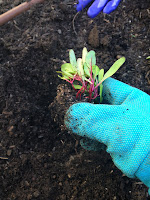If we're not growing, we're staying the same.
 |
| Me, growing. |
Speaking of growing, I read a great story today about a woman named Cecelia Gatungo, who currently lives in Atlanta, GA, but grew up in Kenya. She lived off the land as a child, and wanted the same for the children in her neighborhood. What began as a small garden in her yard, now amounts to a 2,000 sq. ft. farm in the middle of the bustling city. She's partnered with others: churches and schools that have donated land; the University of Georgia which provided advice on garden pests; other urban growers; and even a nonprofit which allows kids to work on the farm. You can read her story here: Growing Wild in the City
 I had my own experience with gardening this summer, and believe that not only is it an experience in personal growth, but it truly brings people together. Working off the land is difficult to describe. There are seeds, dirt and bugs, and there's sunshine and water. Then there are smiles and laughter, and family and friends, and new friends, and caring and sharing, and community. There's learning and growing. There's cultivating and nurturing, and some obstacles along the way. And there's the moment you bite into a tomato or a strawberry you've cared for, and watched grow. Magic.
I had my own experience with gardening this summer, and believe that not only is it an experience in personal growth, but it truly brings people together. Working off the land is difficult to describe. There are seeds, dirt and bugs, and there's sunshine and water. Then there are smiles and laughter, and family and friends, and new friends, and caring and sharing, and community. There's learning and growing. There's cultivating and nurturing, and some obstacles along the way. And there's the moment you bite into a tomato or a strawberry you've cared for, and watched grow. Magic.
If you haven't tried it, you must. Start as big or as small as you'd like. Build a garden in your yard. If you live in the city, try urban gardening (as long as you have a small balcony, you can grow in pots). If you have no outdoor space, invest in a plot in a community garden. Just grow.
Cecelia Gatungo has found a way to grow, not just herself, but her whole community. I'm growing one day at a time. Join me?













